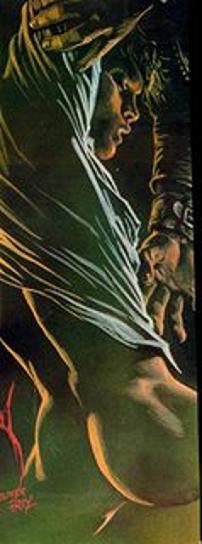Diagnosis and Treatment Plan:
The LOML and Dr. L met with Dr. W, my attending neurovascular surgeon. Dr. A, my world renowned primary neurovascular surgeon, was away on sabbatical, but would return for my surgery.
Dr. W told the LOML that an angiogram revealed that the hemorrhage was due to a ruptured artero-venous malformation, or AVM (see picture of your blogger’s brain) in the left frontal-temporal lobe of the brain.
Background: An AVM is a twisted knot of larger than usual arteries and veins that tend to rupture easily as a person ages and the malformation itself is congenital. As a person ages, the walls of the tiny vessels continue to thin and eventually the AVM is destined to rupture. Contributing factors to the rupture can be high blood pressure and sometimes childbearing. AVM is usually misdiagnosed and found only after a bleed. When actually diagnosed, the patient typically complains of a severe headache and the AVM is then detected by CT scan (computerized tomographic scan) or MRI (magnetic resonance imaging). Treatment plans remain the same in either scenario.
The treatment plan was first to embolize the AVM, which means that glue is gently squirted into it from a catheter, as much as possible, to stabilize it and prevent further bleeding. The second step is to surgically remove as much as possible of the stabilized AVM. The angiogram guided embolization was to take place that afternoon.
The LOML telephoned the insurance company. Now, that is presence of mind!
At some point in the day, our friend Dr. L called his wife, Dr. B, an immunologist. I have known her since 1984, when I worked as safety coordinator and radiation safety officer and she was on my radiation safety committee. Because of her intelligence, diplomacy and sweetness, she was a role model for me and we became close friends in no time. She introduced me to her husband, who I was later to work with in oncology. The four of us became fast friends early on. She set out for the hospital right away to offer her support to the LOML and her husband, and to be with me. The LOML remembers Dr. B speaking with Evie during the day.
Dr. L also telephoned Dr. R, an oncologist, vice president, and ex-boss to both Dr. L and me at work, and let him know what was going on with me and that I was in the hospital. Dr. R and I had worked closely together for about 7 years (up until a year before all of this) on many clinical projects to get drug agents approved for both oncology and AIDS indications. Most of the projects were quite challenging for me and together we achieved drug approvals of importance for patients. We made quite a team. Working with Dr. R changed my life profoundly for the better.
Afterwards, Dr. R communicated my medical status to the entire Oncology Department whom I had formerly worked closely with. We were all a very tightly knit bunch. When my friend Kelli came in to work there later that morning, Lucy, Dr. R’s assistant, told her that I was at the university hospital with a brain hemorrhage. Kelli did not believe her as she had spoken with me just the night before. That weekend Kelli determinedly dug her fish pond by hand.












small.jpg)


1 comment:
Enjoyed a lot! » »
Post a Comment